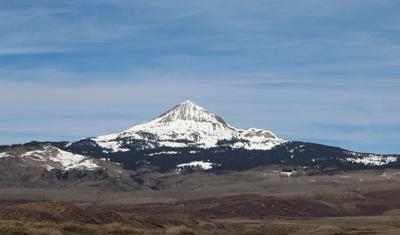Commissioners in San Miguel County this week agreed to provide more feedback on renewable energy standards that are being discussed for inclusion in potential new legislation that could impact local governments’ abilities to exercise control over utility developments.
Colorado Counties Executive Director Kelly Flenniken spoke at Wednesday’s meeting with the commissioners.
Flenniken said a draft bill had not been released as of Wednesday, but “conceptual work” is happening at the state level. The state could move to potentially eliminate setback standards and restrict local governments from passing certain ordinances, which would prohibit local control to pass temporary moratoriums on new utility projects to give local governments time to review and update codes. San Miguel County currently has a moratorium in place on new utility projects as it works to update its regulations and garner public input.
A document presented at the commissioners’ meeting said the state legislation could include standards mandating that “A county may not adopt zoning regulations that disallow, permanently or temporarily, commercial wind or solar energy facilities, or commercial energy storage facilities from being developed or operated in any district zoned to allow agricultural or industrial uses, or any district zoned as Open Space.”
Commissioner Anne Brown said she is concerned about the proposed standard.
“It’s actually requiring, it seems to me, that we allow renewable development in agriculture, industrial and open space areas,” Brown said.
Last year, the San Miguel County Commissioners agreed to continue supporting the historical agriculture land use in place at the base of Lone Cone after a 640-acre proposal for a solar utility project on Wright’s Mesa in Norwood came forward.
Flenniken said Colorado Counties wants “to find ways, if it makes sense in a local jurisdiction, where the agricultural industry is complementary to renewables.”
“We don’t love that it is a blanket [statement],” Flenniken said. “There are ways that these can cohabitate with each other and we want to be able to provide for that flexibility and freedom at the local government level.”
Commissioner Lance Waring said he shares those concerns with Flenniken.
“You’re working with all the counties trying to protect local control while also acknowledging commercial-scale solar is important and necessary and it’s a problem that we’ve been discussing now… for almost a year and we’re wrestling with it,” Waring said.
Flenniken highlighted the current production of renewable energy in the state.
“When we think about the deployment of renewable energy in Colorado, Colorado regularly ranks in the top 10 states that are generating and producing renewable energy. Right now we’ve got almost 8,000 megawatts being produced in Colorado,” Flenniken said.
She encouraged the commissioners to continue asking questions about what problems the state may be trying to solve with its “overreach.”
“It really does beg the question to me of what problem are we solving here by trying to have some state overreach into this area,” Flenniken said, “when counties, cities and other local governments are working to find codes that make sense for their communities that are reflective of their values, and also in a lot of cases, that allow for their comprehensive planning efforts to take place?”
At the conclusion of Wednesday’s discussion, commissioners said they would gather additional feedback regarding proposed renewable energy legislation by Friday afternoon for a meeting that would be happening at the state level.
BUREAU OF LAND MANAGEMENT SOLAR PLAN UPDATES
In other items on Wednesday’s agenda, the commissioners heard an update from San Miguel County Natural Resources and Special Projects Director Starr Jamison about a letter being drafted to send to the Bureau of Land Management (BLM) regarding solar utilities on public lands.
The letter is to provide comment on the BLM’s draft Environmental Impact Statement (EIS) about utility-scale solar energy development that will help to update the “Western Solar Plan.” The plan’s coverage area in 2012 included six states but is expanding to include 11. By 2045, the plan predicts utility-scale solar energy on 1.3 million acres of public lands managed by the BLM. In Colorado, an estimated 45,000 acres will be managed for solar utility development through the BLM. Along with Colorado, the 10 other states are Arizona, California, Idaho, Montana, Nevada, New Mexico, Oregon, Utah, Washington and Wyoming.
San Miguel County’s letter will share concerns with the BLM about wildlife and power lines with an emphasis on buffers with Gunnison Sage-Grouse habitats and protection for rare plant species.
Visit https://tinyurl.com/BLMsolar2024 to view the BLM’s draft EIS on solar energy development.
REFORM AT THE COLORADO ENERGY OFFICE
The BLM is not the only government agency working on reforms this year around renewable energy utilities.
On Tuesday, April 2, the Colorado Energy Office announced it’s funding up to $1 million in grants to local and tribal governments to “implement automated online solar permitting software,” a news release said, for the Automated Permit Processing for Solar (APPS) Grant. Applications are open until June.
Two of the companies that could provide the permitting software to local governments are SolarAPP+ and Symbium. The software, touted as “instant permitting,” has been applied to rooftop and residential solar installs primarily in California. A post on Symbian’s website announced its partnership with the Colorado Energy Office on Feb. 5 as a solution to helping local governments with permits for residential solar energy.
“As only the second state in the U.S. to roll out this type of grant program, Colorado is at the forefront of making solar faster and more accessible to install,” said Colorado Energy Office Executive Director Will Toor. “Assisting cities, contractors, and consumers in getting projects up-and-running faster will help make siting solar cheaper, and the APPS program will aid in this process.”
The office predicts a five-fold growth in solar energy by 2040, which is the year Colorado Gov. Jared Polis wants to achieve 100% renewable energy in the state.
The Colorado Energy Office is prioritizing 2024 legislation to reform and expedite renewable energy permitting.
The office said on Jan. 17 in public meeting documents, and again in its newly released “Greenhouse Gas Pollution Reduction Roadmap 2.0,” that its agenda includes legislation for “modernizing” permitting for renewable energies with “statewide consistency for renewable energy permitting and siting.”
A copy of the roadmap 2.0 document also said the office is initiating action in 2024 to “Expand renewable energy development, transmission on state lands,” and encourage “land use policies to support strategic growth.”
The Colorado House Energy & Environment Committee has legislative oversight of the Colorado Energy Office and the Colorado Public Utilities Commission. The House committee was scheduled to meet on Thursday, April 4.
Both the energy office and the public utilities commission included modernizing permitting for renewable energies in presentations on Jan. 17 for the State Measurement for Accountable, Responsive, and Transparent Government (SMART) Act. Visit https://tinyurl.com/UtilitySMART and https://tinyurl.com/EnergyOfficeSMART to view copies of the presentations.





























Commented
Sorry, there are no recent results for popular commented articles.